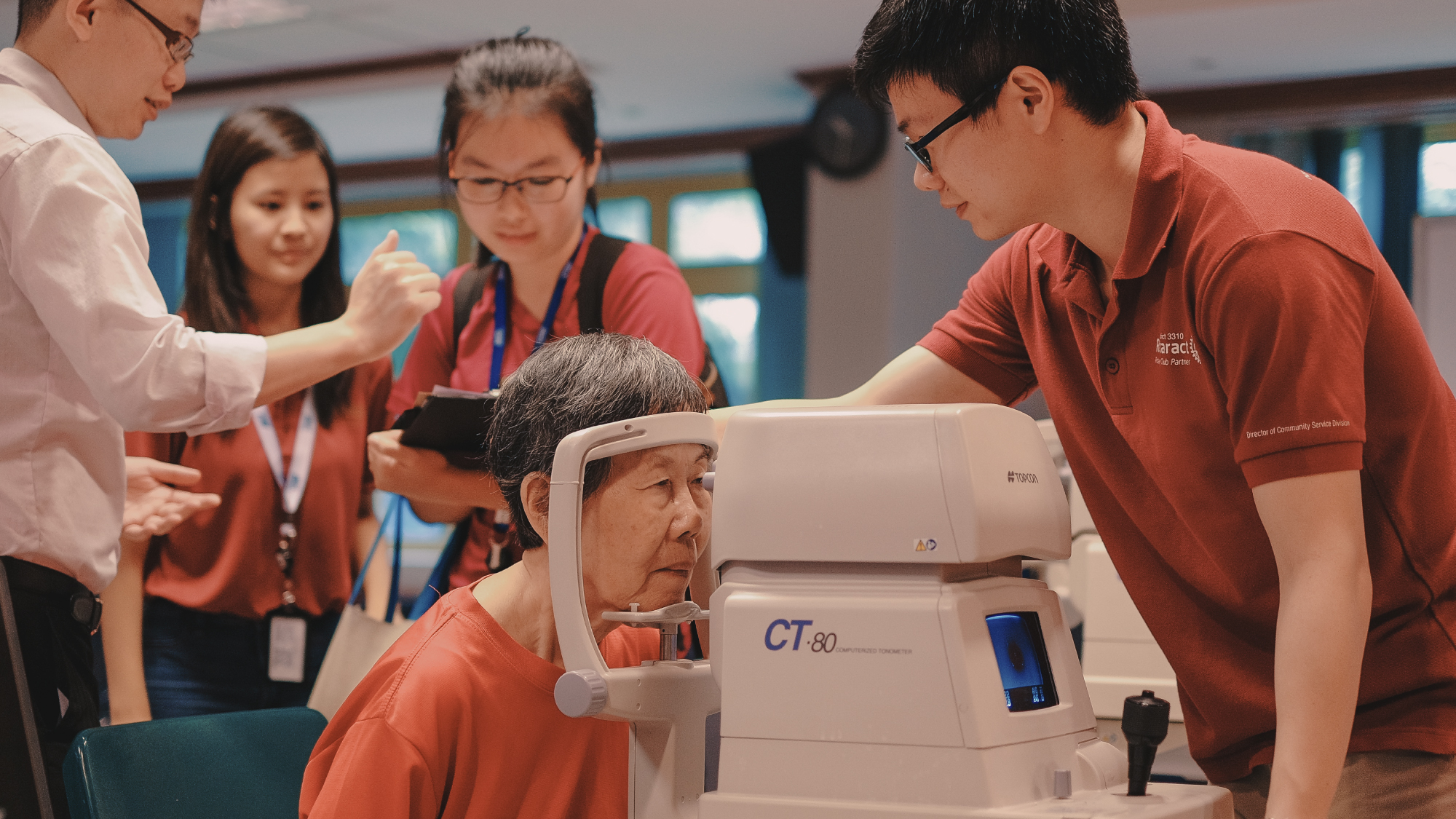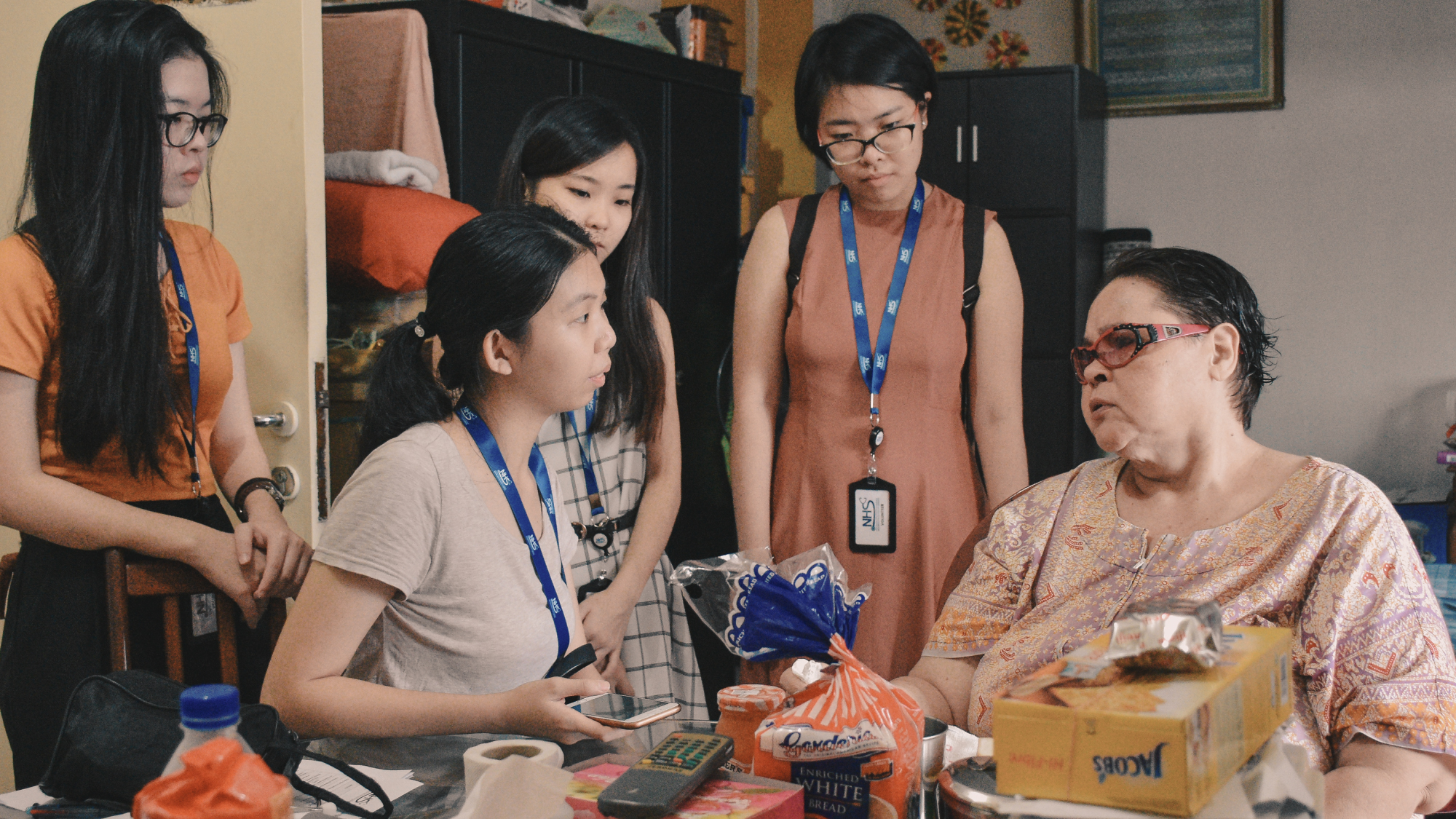Neighbourhood Health Service 2018 – Bringing together the nation’s key players in healthcare delivery
By Benjamin Tan Kye Jyn and Koh Ying Ying
Co-Directors, Neighbourhood Health Service 2018
Phase II Medicine Students
Singapore’s pioneering student-led health screening programme for residents of rental HDB apartments has expanded significantly this year, the 12th since the programme began in 2007.
In September and October 2018, the Neighbourhood Health Service (NHS) brought its health screening and follow-up programme to residents in Kampong Glam and Queenstown (Leng Kee). Student volunteers reached out to more than 8000 households and conducted health screening for 863 residents in the comfort of their own homes.
The flagship community service project of the NUS Yong Loo Lin School of Medicine is the only student-led school project that has nationwide reach and scale, involving all three Regional Health Systems (NUHS, SingHealth, NHG) in serving close to 6,000 residents in 10 different districts since 2007.
Singapore’s first Integrated Community Health Screening
For the first time this year, NHS established a six-way partnership involving the Ministry of Health (MOH), respective Regional Health Systems, Health Promotion Board (HPB), Agency for Integrated Care (AIC), Singapore Eye Research Institute (SERI), National Dental Centre Singapore (NDCS) and Singapore Cancer Society. This replaced the conventional practice of holding separate screenings for different modalities, saving residents a significant amount of time.
Residents were assessed via multi-level tests in five distinct categories through a “one-stop shop” screening covering:
• Chronic diseases (diabetes mellitus, hyperlipidaemia, hypertension, obesity)
• Functional modalities (vision, oral health, hearing)
• Fall prevention (screening and education)
• Cancer (colorectal, cervical, breast)
• Mental health (dementia, depression)
• Social work (financial, social, psychological
Notably, basic and advanced screenings for vision and oral health were conducted on the same day at NHS, with the strong support of long-time partners SERI and NDCS. Usually, elderly screened under HPB’s Project Silver Screen functional screenings would have to make separate trips post-screening to community-based mobile clinics for advanced eye and dental checks. For elderly residents of rental apartments, many of whom have no family to accompany them on medical appointments, removing this additional barrier would likely encourage follow-up.
Bringing the key healthcare institutions on board means that the screenings this year were holistic, community-based health screenings, aligned with nationwide screening efforts.

Phase I Medicine student with a resident during the door-to-door screening.
“It is also the first of its kind in the country”, said Associate Professor Gerald Koh of the Saw Swee Hock School of Public Health. He and a team of doctors from the National University Health System (NUHS), SingHealth and National Healthcare Group (NHG) have been advising and mentoring NHS.
Officers from the MOH Ageing Planning Office who attended NHS’ Kampong Glam screening expressed interest in modelling this approach to integrate multi-level chronic disease and functional screening efforts in other districts nationwide. Officers from the MOH Health Regulation Group and MOH Office for Healthcare Transformation also studied NHS’ unique approach at Kampong Glam and Queenstown (Leng Kee).
Door-to-door screenings are cost-effective
In addition to door-to-door publicity, NHS also pioneered the unique approach of door-to-door screenings and follow-up many years ago. Healthcare students equipped with the relevant equipment would visit residents, in particular those who are immobile, to conduct health screenings in their homes.
In line with its long-term goal of evolving into a replicable, scalable health service model, NHS sought to evaluate the cost-effectiveness of its labour-intensive, active approach. To do so, NHS worked with a team of NUS Business students, mentored by Associate Professor Albert Teo (Director, Chua Thian Poh Community Leadership Centre).
The team conducted a social return on investment (SROI) analysis in 2015 and found that for every $1.00 invested in NHS over a five-year cycle, $2.29 in social returns were generated yearly on average. This shows, perhaps counter-intuitively, that the door-to-door approach is in fact cost-effective. Today, door-to-door healthcare is being implemented across the island.
Follow-up care, driven by research
Every year, NHS also engages in population health research under the Saw Swee Hock School of Public Health. In the past, NHS found that residents living in HDB rental blocks were four times less likely than the average Singaporean to go for regular health check-ups. Additionally, only 11 percent of rental block residents preferred to approach Western-trained doctors, while 30 per cent preferred alternative medicine. Another 53 per cent indicated a preference for “self-reliance”.
These findings spurred NHS to expand its follow-up programme. And so, close to 300 residents with abnormal results for chronic disease screenings (i.e. 30 percent of residents who were screened) were selected for follow-up last year. The aim was not to replace primary care physicians or to prescribe medicines, but to motivate these residents to follow-up with their family doctors on their screening results.
Trained by the NUHS Department of Family Medicine in motivational interview techniques frequently used to counsel patients, NHS student committee members engaged residents in conversation via phone calls and house visits in more complex cases. This was done at regular three-monthly intervals, for up to a year after the residents’ screening. At these sessions, the residents were encouraged to adopt positive health-seeking behaviour.
The changing healthcare landscape
This year, a multitude of new programmes were launched to help seniors age-in-place. These include AIC’s Care Close to Home pilot, which assists elderly rental block residents with activities of daily living and management of chronic conditions, as well as SingHealth’s Community Nurse Posts and NHG’s Community Health Posts, which aim to rehabilitate frail elderly and reduce the rate of hospital admissions.

A resident gets her vision checked.
In September 2018, NHS brought these partners together to integrate our approaches and minimise overlap. While discussions are still ongoing, the goal of synergy is in sight and residents screened in 2018 can expect to have a single main organisation in charge of their follow-up.
The team is proud to represent NUS Medicine in bringing together the key national players, and is sincerely grateful for our mentors’ excellent guidance and the school’s unwavering support. Along with A/Prof Koh, mentors who NHS worked closely with this year also include A/Prof Tay Sook Muay (Associate Dean, NUS Medicine, SGH
Campus), Dr Sue-Anne Toh (Clinical Director, NUHS RHS Planning & Development), Dr Ian Wee (Senior Resident, Internal Medicine, SGH), Dr Chiong Yee Keow (Senior Resident, Paediatrics, NUH) and many more who have guided NHS in one way or another.
The team would also like to thank all residents, volunteers, partners and sponsors for their unwavering support over the past year. The next NHS committee will continue to improve and adapt amidst the changing healthcare landscape, driven by our common passion to make a positive difference in the community!

NHS student representatives visit a resident.
